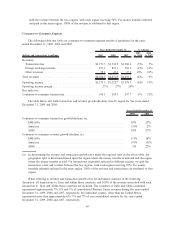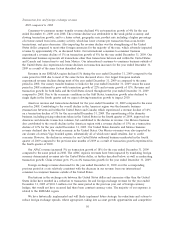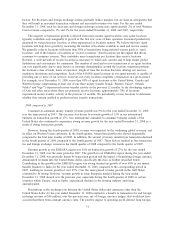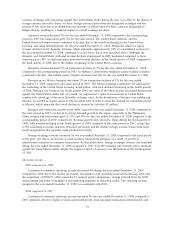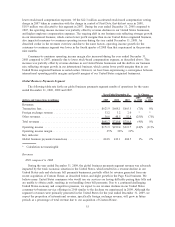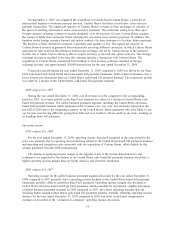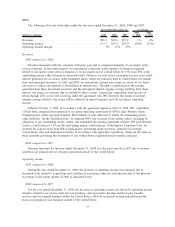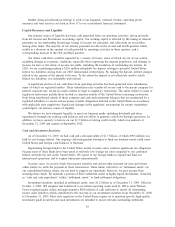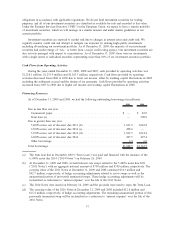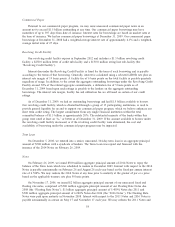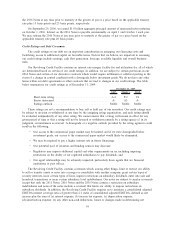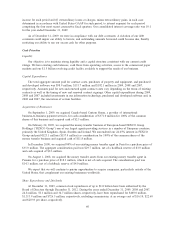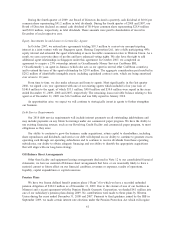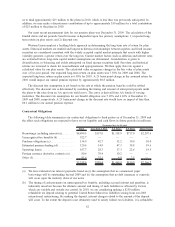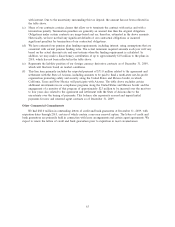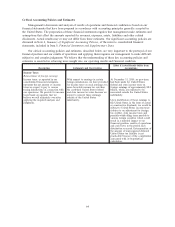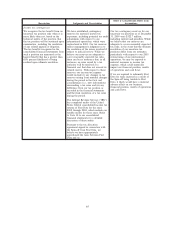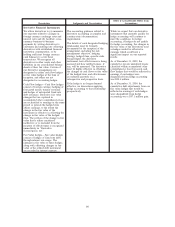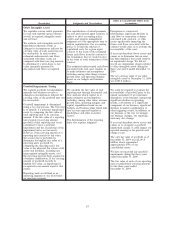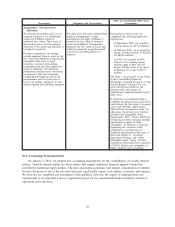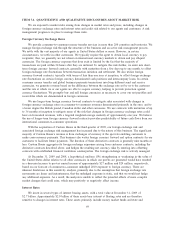Western Union 2009 Annual Report Download - page 73
Download and view the complete annual report
Please find page 73 of the 2009 Western Union annual report below. You can navigate through the pages in the report by either clicking on the pages listed below, or by using the keyword search tool below to find specific information within the annual report.
the 2036 Notes at any time prior to maturity at the greater of par or a price based on the applicable treasury
rate plus 15 basis points and 25 basis points, respectively.
On September 29, 2006, we issued $1.0 billion aggregate principal amount of unsecured notes maturing
on October 1, 2016. Interest on the 2016 Notes is payable semiannually on April 1 and October 1 each year.
We may redeem the 2016 Notes at any time prior to maturity at the greater of par or a price based on the
applicable treasury rate plus 20 basis points.
Credit Ratings and Debt Covenants
The credit ratings on our debt are an important consideration in managing our financing costs and
facilitating access to additional capital on favorable terms. Factors that we believe are important in assessing
our credit ratings include earnings, cash flow generation, leverage, available liquidity and overall business
risks.
Our Revolving Credit Facility contains an interest rate margin, facility fee and utilization fee, all of which
are determined based on certain of our credit ratings. In addition, we are subject to certain provisions in our
2014 Notes and certain of our derivative contracts which would require settlement or collateral posting in the
event of a change in control combined with a downgrade below investment grade. We do not have any other
terms within our debt agreements or other contracts that are tied to changes in our credit ratings. The table
below summarizes our credit ratings as of December 31, 2009:
S&P Moody’s Fitch
December 31, 2009
Short-term rating . . . ............................... A-2 P-2 F2
Senior unsecured . . . ............................... A- A3 A-
Ratings outlook................................... Stable Stable Stable
These ratings are not a recommendation to buy, sell or hold any of our securities. Our credit ratings may
be subject to revision or withdrawal at any time by the assigning rating organization, and each rating should
be evaluated independently of any other rating. We cannot ensure that a rating will remain in effect for any
given period of time or that a rating will not be lowered or withdrawn entirely by a rating agency if, in its
judgment, circumstances so warrant. A downgrade or a negative outlook provided by the rating agencies could
result in the following:
• Our access to the commercial paper market may be limited, and if we were downgraded below
investment grade, our access to the commercial paper market would likely be eliminated;
• We may be required to pay a higher interest rate in future financings;
• Our potential pool of investors and funding sources may decrease;
• Regulators may impose additional capital and other requirements on us, including imposing
restrictions on the ability of our regulated subsidiaries to pay dividends; and
• Our agent relationships may be adversely impacted, particularly those agents that are financial
institutions or post offices.
The Revolving Credit Facility contains covenants which, among other things, limit or restrict our ability
to sell or transfer assets or enter into a merger or consolidate with another company, grant certain types of
security interests, incur certain types of liens, impose restrictions on subsidiary dividends, enter into sale and
leaseback transactions or incur certain subsidiary level indebtedness. Our notes are subject to similar covenants
except that only the 2011 Notes, 2016 Notes and the 2036 Notes contain a restriction on subsidiary
indebtedness and none of the notes include a covenant that limits our ability to impose restrictions on
subsidiary dividends. In addition, the Revolving Credit Facility requires us to maintain a consolidated adjusted
EBITDA interest coverage ratio of greater than 2:1 (ratio of consolidated adjusted EBITDA, defined as net
income plus the sum of (a) interest expense, (b) income tax expense, (c) depreciation expense,
(d) amortization expense, (e) any other non-cash deductions, losses or changes made in determining net
59


